EYFS best practice - All about… under-threes’ physical development
Carol Archer
Monday, August 6, 2018
Why movement is important for the youngest children and how settings can best provide opportunities to practise it. By Carol Archer

Young children’s physical development (PD) is critical to their health, well-being, school readiness and, most importantly, their brain development and early learning. Children need to be able to move freely if they are to explore and learn about their world, and the very act of moving helps to ‘wire up’ the child’s brain, building the central nervous system and shaping the architecture of the brain.
CURRENT TRENDS
Obesity
In the UK, obesity in toddlers has risen steadily over the past two decades, with recent statistics revealing that some 13 per cent of two- to four-year-olds are obese and a further 16 per cent overweight (PHE 2016). These figures are even higher for children during the primary school years (HSCIC 2013), raising concerns about children’s health and well-being.
Both poor eating patterns and physical inactivity play a part in the growing incidence of childhood obesity, and unhealthy diets and sedentary behaviour established in childhood are likely to continue in adulthood (DHSC 2011). Unsurprisingly, therefore, transition to school is becoming far more difficult for some children (Docket et al 2014).
School readiness
Sally Goddard Blythe (2005) questions whether or not every child is ready for school in terms of their neuro-motor development, which describes a range of skills including posture, balance and co-ordination. If these physical foundations for learning are secured in the pre-school years then children enter the school system better equipped to cope with the demands of the classroom, such as the ability to sit and concentrate, co-ordinate hand and eyes when writing and control eye movements for reading.
For young children to cope with the more formal classroom, we need to ensure that all infants and young children are provided with opportunities to develop early movement patterns. If children are to be ‘ready for school’ then they need to be physically ready, and we would be wise to take this seriously (Goddard Blythe 2005).
Prime area
The importance of physical development is recognised within the EYFS, as it is one of the three Prime areas of learning. It underpins all aspects of early learning and development and should be a central plank of planning and provision within settings.
Lack of knowledge, however – largely due to a lack of continuous professional development (CPD) – often means that settings fail, or struggle, to respond to young children’s inactivity. Some practitioners assume that infants and young children move anyway, so adults don’t need to do anything. Or practitioners believe that typical nursery provision is enough to encourage children to be physically active (Archer and Siraj 2015a).
Recent years have also seen a gradual narrowing of the early years curriculum – with priority being given to reading, writing and maths, distracting some settings from focusing on children’s holistic development and the Prime areas of learning. Physical development, for example, is largely ignored within Ofsted’s Bold Beginnings report, yet children can undoubtedly enjoy a myriad of benefits from being physically active, which will support reading, writing and maths development.
These trends make it imperative that settings offer children from the earliest of ages a healthy balanced diet in conjunction with appropriate levels of physical activity. Closing the gap between what is believed to be happening and what is actually taking place requires not just knowledge, understanding and training; it also requires effective management (see case study).
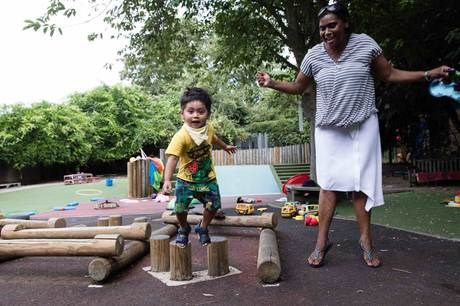
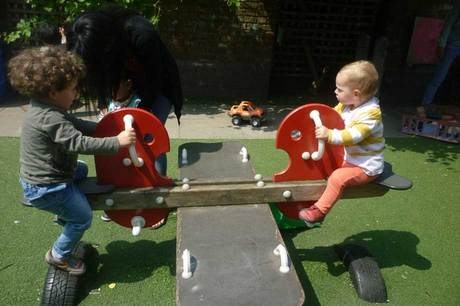
Pre-schoolers capable of walking unaided should be active for 180+ minutes a day
STARTING POINT
As a starting point for addressing young children’s levels of inactivity, practitioners should turn to Start Active, Stay Active (2011), a report on children’s physical activity by the four national Chief Medical Officers in the UK. Contained within it are the CMOs’ guidelines for physical activity in children under five. These state that:
- Physical activity should be encouraged from birth through floor-based play and water-based activities in safe spaces.
- Children of pre-school age who are capable of walking unaided should be active daily for at least 180 minutes spread throughout the day.
- All under-fives should minimise the amount of time spent being sedentary (being restrained or sitting) for extended periods (except when sleeping).
Plans are afoot to change these to 24-hour guidelines, incorporating physical activity, sedentary behaviours, nutrition, screen time and sleep. The current guidelines have on the whole been poorly disseminated and what will be critical is that all settings receive and respond to any revised guidance.
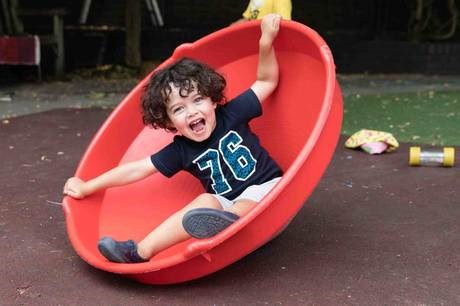
PRINCIPLES AND PRIORITIES
Whatever the official guidance, settings need to respond to it appropriately, bearing in mind the principles and priorities within early years practice and avoiding being distracted or misled by any policy pressures.
Remember that:
- Every child is unique. Development Matters in the Early Years Foundation Stagequite rightly informs us that children develop at their own rates and in their own ways and practitioners should familiarise themselves with the document’s overlapping age and stage bands, which suggest a typical range of development.
- Settings should take play-based approaches to promoting children’s physical activity and provide opportunities that will enable children to move creatively and to build up an expansive repertoire of movement. These should be observed, respected and assessed over time.
- Movement play isn’t just for the outdoors. Movement and physical activity rarely take place indoors in many settings but it should be part of daily indoor provision.
- Within the range of movement opportunities that settings offer, settings should give priority to children crawling on their tummies and on their hands and knees, as well as moving in ways that will promote their vestibular and proprioceptive systems.
TUMMY TIME
Movement is the child’s first language, right from the time the foetus kicks and pushes on the boundaries of the womb. After birth, infants’ spontaneous wiggling of arms and legs indicates their search for early movement patterns. It is wise to watch with interest and in awe as they reveal their sequential developmental stages towards significant patterns of movement.
Development of the early movements enables the infant to move along the floor on their tummy, exploring their environment in their drive to make sense of their world from the physical actions they perform within it. The determination to relate to those around them will motivate the infant to push and pull their body along to interact with their peers and significant adults – never underestimate how much an infant wants your company down on the floor. These first independent movements are a specific milestone that deserves much celebrating with the baby.
The next stage of development is for a child to move from tummy time to sitting upright, but many babies are being propped to sit up before they are ready to do so independently. It is not uncommon to hear about babies who are able to sit upright but don’t yet crawl, even though they are a year or more in age. In nearly all cases, in my experience, these babies have not been placed on their backs or tummies regularly. Instead, they have been propped up to sit and then lifted from place to place by an adult.
As a result, these babies adopt passive behaviours, waiting for others to move them. They may appear to be happily watching what is going on around them, but they will always be able to explore their physical potential better and more freely when placed on their backs or tummies.
When placed regularly on their backs, a baby will over time master the skill of rolling from their back to their tummies and back again as they reach for toys and explore the world around them. These early independent movements are crucial for the child to feel the sense of movement and have some level of awareness that they can make movement happen, rather than waiting for others to move them.
Baby swings, baby walkers, doorway bouncers, rocking bouncy cradles and the like have much to answer for in preventing children passing through this critical stage of development. New parents can be seduced by manufacturers’ claims that these products will help their baby’s ‘development’. In reality, they merely contain, preventing the baby from moving and wriggling, and so actually interfering with development.
Sitting upright in baby equipment impedes the development of a baby’s postural muscles, which will affect their posture later on. If babies are sat upright before their spines are ready they can develop scoliosis – an abnormal curvature of the spine (Lamont 2011).
When babies are not sleeping, being nursed or cradled in loving arms, they need to be able to move freely on their backs or tummies on the floor. If a baby is not yet able to sit up independently, they should not be placed in a swing or similar product that holds them up unnaturally. If they are able to sit up independently, the baby does not need a device to hold them up.
‘Containment’ equipment does nothing to trigger brain development, as the baby is immobile and, therefore, unstimulated. When placed in these products, babies go into a ‘neurologically neutral place’, and there is no time to waste in the first year of life being left in ‘neutral’ (Lamont 2011).
Benefits of tummy time (Lamont)
- While crawling on their tummy, a baby’s eyes are tracking horizontally – a vital skill needed when reading later in their development.
- When pushing and pulling themselves along the floor, babies begin to open out their hands, strengthening their arms, fingers and upper body.
- Crawling barefoot enables the baby to push with their toes to propel themselves forward, strengthening the arches in the feet.
- As the baby lies on their tummy and moves their head from side to side, the skull will round out naturally, rather than developing a flat area on the head from sitting in a carrier seat or lying on their back for too long.
- Tummy time stimulates the pelvic area, which will support children’s readiness for toilet training at a typical stage of development.
- From a position of lying on their tummy, babies will be able to roll one way then the other, move along the floor and eventually push themselves up on all fours to crawling.
Space and resources
To support a child during ‘tummy time’, ensure the floor space is clean and surfaces are easy to move along, and provide:
- balls, small and large – children enjoy rolling small ones across the floor and being supported to lie and roll on larger gym balls. Moving slowly backwards and forwards on a ball can also often calm a child who is feeling unsettled
- cushions to roll on
- a mirror. Position it so the infant can see themselves in it as they are lying on their tummy. This will encourage them to push themselves up on their hands and lift their upper body
- pieces of material. Lay the child on the material and pull them along the floor.
In practice
The floor is an important workplace for infants and young children where they can practise, rehearse and revise significant movement patterns until they are ready to move onto their next developmental stage. Playing on the floor also provides a perfect opportunity for practitioners to observe a child’s movement patterns closely.
For example, when working with Harmony Neighbourhood Nursery in west London (see case study), we noticed during one observation of a two-year-old boy that he had not yet developed the cross-lateral pattern when crawling – that is, moving in tandem the right arm and left leg followed by the left arm and right leg. It was clear that he would need more practice crawling on his tummy and on all fours for his arms and legs to co-ordinate in this pattern.
ON HANDS AND KNEES
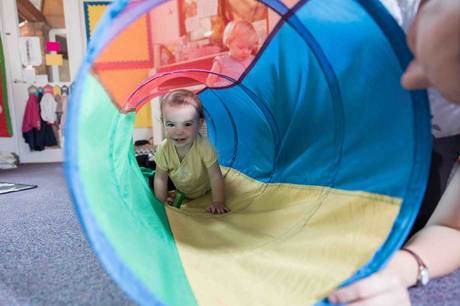
Crawling on hands and knees is another early significant movement pattern but should not be restricted to infants. All young children should return to this way of moving. Some practitioners provide a specific time for movement each day or a few times a week, organising the environment for children to be physically active indoors for 20 to 30 minutes. During such sessions, children are barefoot and encouraged to crawl, roll and spin, as well as being given the time to move freely as their bodies desire.
Benefits (Lamont)
- Crawling on hands and knees builds the bridge between the right and left hemispheres of the brain through the corpus collosum, creating neurological connections between the two hemispheres, so the more a baby crawls, the faster these connections will transmit information.
- A cross crawl movement stabilises the pelvis while aligning the spine and helps the shoulders and hips to rotate into alignment in preparation for walking.
- The hands are opened out more fully, strengthening them and preparing them for the development of fine motor skills.
- Crawling is the first time the infant’s body is balanced when off the floor, which forms the foundation of balance throughout their life.
- The eyes track vertically and horizontally when crawling, which will support the child’s ability to track text when reading and writing, as well as the hands on a clock to read the time.
- Eye-hand co-ordination continues to develop during this movement pattern, which is essential for writing.
SENSORY SYSTEMS
In addition to the five senses of sight, smell, taste, hearing and touch, we have two other vital senses that settings should aim to develop in young children through movement. These are our vestibular and proprioceptive systems.
The vestibular system
The vestibular system is the sensory mechanism in the inner ear that detects movement and enables us to maintain our posture, control our movements and be able to balance. When this system is functioning well, children will feel confident with their internal balance system and will respond to vigorous vestibular activity with enjoyment.
Activities
It is constant motion that activates the vestibular system, which is stimulated by many activities from birth, such as:
- rocking a baby gently to and fro
- whooshing an infant up and down in an adult’s arms
- spinning around until dizzy and falling down
- whooshing down a slide fast
- rolling across the floor with a friend or alone
- spinning inside a cone
- hanging upside down and swinging on monkey bars or climbing frames
- rough-and-tumble activities and falling down.
Proprioceptive system
Proprioceptors are located in our muscles and joints and are activated by bodily movement, letting us know unconsciously where each part of our body is in relation to the rest, how it is moving, and where our bodies are in space (Hannaford 1995). So, a well-functioning proprioceptive system enables us to dress in the dark.
This system works together with vision, touch and the vestibular system to support children in their drive to reach developmental milestones, such as rolling over, crawling on their tummies and on all fours, pulling up to cruise, then walking. The proprioceptive system needs to be in good working order for the young child to be a willing participant and thrive when engaged in movement and more vigorous physical activities.
Activities
The types of vigorous activity that children enjoy and help develop children’s proprioceptive system are:
- being wrapped up tightly in a piece of Lycra, then unrolled quickly to create a whirling dizzy sensation (see below)
- pulling up on equipment such as a slide or monkey bars
- being sandwiched between two cushions
- moving and falling
- being given big bear hugs
- pushing heavy wheelbarrows
- pulling on a rope or material in a tug-of-war game
- rough-and-tumble activities
- climbing up and down trees and climbing walls
- jumping on the spot or from different heights.
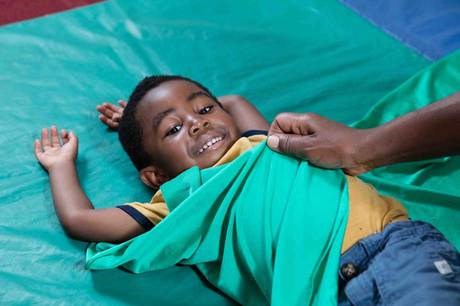
Space and resources
Settings should aim to provide spaces and resources both indoors and out to help develop children’s vestibular and proprioceptive systems.
Indoors
Here, settings should provide:
- space for crawling on the tummy
- space with mats and cushions for rough-and-tumble play or experimenting with body movements
- stretchy material for playing tug-of-war
- cushions for a child to be sandwiched between and pressure applied
- boxes and sofas to jump off
- cardboard boxes to squeeze into.
Outdoors
Children must have access to outdoor space every day whatever the weather; it is imperative for their health, well-being and development. Sufficient space outdoors for energetic physical play is, therefore, essential for all young children, and settings need to provide a range of spaces and resources that will accommodate their varying ages and physical capabilities. For example, provide:
- spaces for babies to lie safely on their backs and tummies, roll over and crawl around on hands and knees
- tunnels to crawl through
- equipment for different age groups to climb on
- a variety of play surfaces such as grass, bark chippings, even and uneven terrain as well as ‘hills’ to climb and roll down
- both portable and fixed equipment, such as mats to perform spontaneous movements on, climbing apparatus, A-frames and ladders, slides, spinning tops, monkey bars, ropes to swing on, structures to jump off, wheelbarrows and buckets for transporting heavy things in, balancing equipment
- natural play spaces with plants and trees
- planting areas or containers
- spaces to be still and quiet in a hammock, den or tepee, or under a tree.
Case study: Harmony Neighbourhood Nursery, west London
CPD training and effective management have boosted the team’s knowledge of early physical development and children’s activity levels at Harmony Neighbourhood Nursery in west London (pictured).
Before doing the training, many of the practitioners hadn’t heard of the vestibular and proprioceptive systems and their benefits to children’s learning and development (see below).
Central to the success of the CPD was getting the practitioners to do the activities that develop these systems, so experiencing for themselves what it was like to crawl on their tummies and hands and knees and to roll across the floor and get dizzy.
Learning about and doing the movements gave staff the motivation and confidence to change their practice. Within three weeks of the training, the practitioners were feeling more confident and within six were relaxed about me observing, advising and supporting the further development of their practice.
As with many settings, indoor movement and physical activity at the nursery was limited, whereas now they have the confidence to reorganise their environment and implement activities enabling children to be more active. Children are now moving in many different ways, on their own and in small groups with the adults.
One practitioner, Josephine, said that after training she was ‘even more eager to participate with children in these movements’, and while initially ‘a bit nervous that I might not do it right’, she has grown in confidence. The children enjoy these activities, she said, and ‘that is my reward’.
Manager Jana Hassan has also played a significant role in bringing about progress in the nursery’s practice, through initiating training, organising structures to support staff, buying equipment and welcoming follow-up work and meetings with parents.
She takes a ‘distributed leadership’ approach (outlined in Archer and Siraj (2015b), in which other members of staff also take on responsibilities voluntarily or through recognition of their strengths. So, deputy head Shandia Chua co-ordinates the delegated responsibilities with a lead person in each room and all staff play a part in implementation.
Now, all the staff join the children in the movement activities, knowing their roles and taking responsibility for children experiencing a beneficial and enjoyable time in nursery.
References and further reading
- Archer, C and Siraj, I (2015a) ‘Measuring the quality of movement-play in early childhood education settings: Linking movement-play and neuroscience’, European Early Childhood Education Research Journal, 1 (1)
- Archer, C and Siraj, I (2015b) Encouraging Physical Development through Movement-Play. Sage
- Archer, C and Siraj, I (2017) Movement Environment Rating Scale (Movers) for 2-6 year olds provision. Improving physical development through movement and physical activity. Trentham
- Department of Health and Social Care (2011) Start Active, Stay Active. www.gov.uk/government/publications
- Dunlop, AW (2008) A literature Review on Leadership in the Early Years. Learning and Teaching Scotland
- Perry B, Dockett S, Petriwskyj, A (Eds) (2014) Transitions to School: International Research, Policy and Practice. Springer
- Early Education (2012) Development Matters in the Early Years Foundation Stage (EYFS). www.early-education.org.uk
- Goddard Blythe, S (2005) The Well Balanced Child: Movement and early learning. Hawthorn Press
- Hannaford, C (1995) Smart Moves: Why learning is not all in the head. Great Ocean Publishers
- Health and Social Care Information Centre, Lifestyle Statistics (2013) Statistics on Obesity, Physical Activity and Diet: England
- Lamont, B (2011) Personal communication. For further information, see: https://neurologicalreorganization.org/articles/babies-naturally
- Ofsted (2017) Bold Beginnings: The Reception curriculum in a sample of good and outstanding primary schools. www.gov.uk/government/publications
- Pre-school Learning Alliance (2018) Moving Right from the Start. www.pre-school.org.uk
- Siraj-Blatchford, I and Manni, L (2007) Effective Leadership in the Early Years Sector: The (ELEYS) study. Institute of Education, London University
Carol Archer is a movement consultant and practitioner, movedtolearn@birthto6.co.uk




